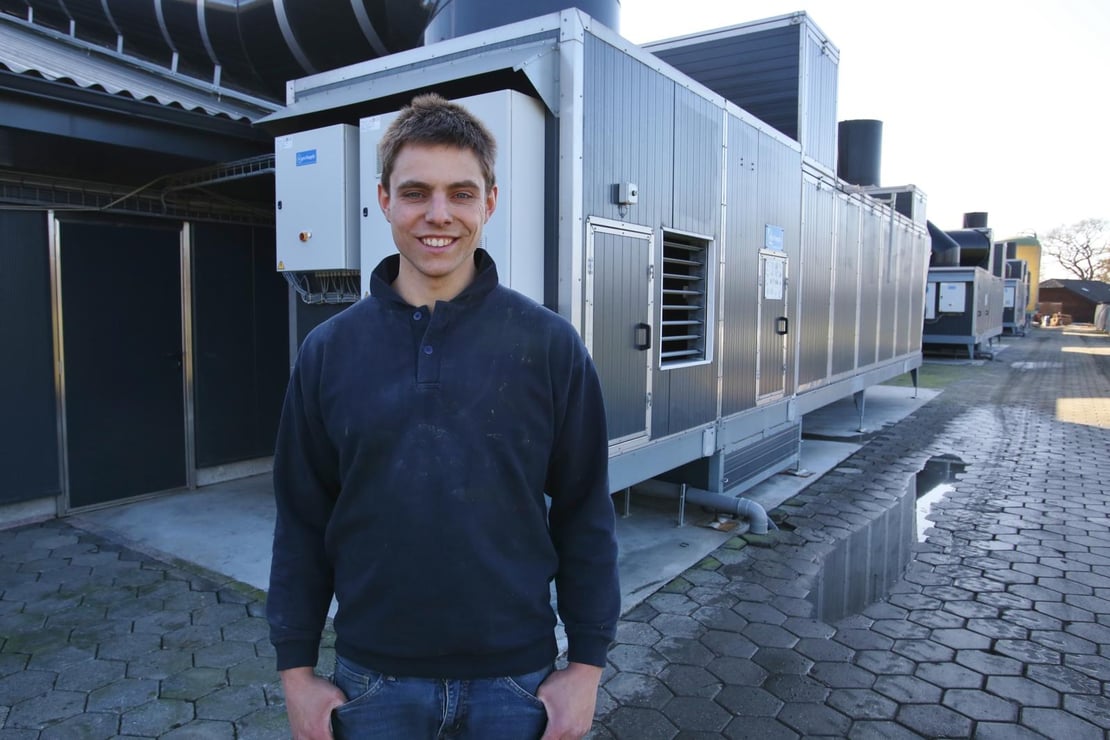In Lunteren in the Netherlands, we find one of the first trial poultry houses with the ECO Zero system. 'I am absolutely satisfied. The climate is perfect, and the results of the hens are great. Despite very high outside temperatures, there is no heat stress and an 80 percent reduction in fine dust', says Arnaud Verbeek.
The poultry farmer is enthusiastic. His current Dekalb white flock, the second in the new house, produced 288 eggs per hen at 62 weeks of age, 1.91 percent mortality, a cumulative feed conversion rate of 2.03 and laying percentage is still at 95.3 percent. 'I'm happy with the new poultry house. It's great to work with, and the results don't lie. The previous flock was still laying at 87 percent after 87 weeks and produced above 90 percent after 60 weeks. We were at 25 eggs above average with 4.95 percent mortality and cumulative feed conversion of 2.06', says Arnaud, visibly proud. He attributes part of the good results to the good climate thanks to ECO Zero. 'Always a constant temperature, cooling when it's too hot, heating when it's too cold and hardly any dust.' In the mornings, he starts his rounds in the new house. Then at 10 am, he, his wife Renate, and their two children go to the rented poultry house to collect the eggs. 'You notice the difference; the negative pressure ventilation system in the rented house is outdated. The litter gets moist more quickly. You notice it in the egg quality as well.'
On the north side of his new laying house, there are three ECO Units. Those units have met his expectations for more than 100 percent. 'The results have been great, both in the last flock and with his current flock. It's a great way to work, and we're expecting to achieve a high reduction in ammonia', says Arnaud Verbeek. 'I have different clothes for the poultry house at home and the rented house. You can even smell which clothes I wore in which house. That's how big the climate difference is.' In the new house, you won't see a single spider web. 'You really can look from the front to the back and see the door handle 95 meters away. That says a lot. If I were to build again, it would definitely be with the units,' says the satisfied poultry farmer.
Recognised finedust reduction
After completing his diploma in agriculture in Barneveld, the 25-year old Verbeek worked on a goat farm but wanted to go into poultry farming. He has a business together with his parents. His parents are responsible for the 120,000 laying hens in Woudenberg. Arnaud and his wife are responsible for the new poultry house on their property and a rented house in Woudenberg.
The municipality required a substantial reduction of emissions before he could build a poultry house on his grandparents' former mixed farm. 'Here, we live in a very poultry-dense area. There are 300,000 hens within a 500-metre radius.
The condition for building here was that we had to make a substantial cut in terms of emissions, which is why the ECO Zero system came into the picture.' The ECO Zero system has a recognised 80 percent reduction of finedust and has a low ammonia emissions per animal space.
Verbeek built the poultry house in 2018: a house of 95 metres in length and 22 metres in width. The outside bird area was built on one side, the south side. 'I really wanted all popholes on one side to prevent drafts. This also fits well with the total plot of 13 hectares for the total outside area for the birds. The east side always has an adverse effect; the south gives warmer air.'
Full ventilation
The ECO Zero system is a complete climate control system with a heat exchanger and cooling. The climate system cools and heats houses and reduces fine particulates. All the ventilation goes through the unit. We installed a maximum ventilation at 3.6 cubic metres per hen per hour. That is far less than the usual 7 to 8 cubic metre per hen per hour.
'We constantly have an optimal climate in the house. Even when the popholes are open because of the equal pressure,' says Verbeek. The air can enter the house pre-heated and dries the manure on the manure (conveyor) belt. Incoming air can also be cooled. Outgoing air is humidified for this purpose, causing its temperature to drop and transfer the cold to the incoming air. Thanks to both principles, the house's temperature never drops below 20 degrees in winter and almost always stays below 27 degrees in summer. Also, 80 percent of the fine dust is removed by filtering the outgoing air. Verbeek placed ventilation shafts on the roof as a precaution, and because he was the first to use the ECO Zero system, but they have not been used yet.
No heat stress
The new house in Lunteren was thoroughly tested during its first summer. While the temperature outside climbed to 42 degrees Celsius, the new house's temperature remained below 29 degrees Celsius. 'The relative humidity inside remained good at about 45 percent. A disadvantage of other cooling systems is often the moist air, which in turn affects the litter ', says Verbeek. His hens had no heat stress at all. The production remained stable, the hens did not eat any less feed, and there was no mortality. 'The scratching area remained dry. It was perfect, really.' The ECO Zero system also ensures the house is much less dusty due to the much quieter ventilation. The system is a cleverly designed heat exchanger, expanded with indirect adiabatic cooling with water. This water-cooling also ensures fine dust is washed away. In winter, the hens are not too cold, and in summer, they are not too hot. 'Health-wise, everything is running smoothly. The vet hardly ever has to come to our business.' The units require little maintenance. Verbeek checks the system quarterly to make sure everything still functions optimally from a technical perspective. The units have an automatic flushing system that runs every three days. During the downtime, Verbeek cleaned the units down.
The hotter, the more cooling power
The ECO Zero system cools using indirect adiabatic cooling, also known as evaporative cooling. 'We all know adiabatic cooling from everyday life. If you rub your damp skin, you immediately notice the cooling effect of evaporation. The effect is even stronger if you stand in the wind with a wet T-shirt. The T-shirt is the carrier for the water. In the ECO Zero system, these are the slats in the ECO Unit. The water evaporates in the outgoing air due to the passing air flow, which also cools the incoming air without making it more humid,' explains Victor van Wagenberg, product manager at Vencomatic Group.
In indirect systems, the air cooled by evaporation does not enter the house, but the cold is transferred to the other incoming airflow via the heat exchanger. Thus, indirect adiabatic cooling works with two air flows: the humidified processed air and the supply air to be cooled. The outgoing processed air is humidified and passed through the heat exchanger, where it releases its cold to the heat exchanger and is then discharged to the outside. In the heat exchanger, the incoming air (outside air) can absorb cold without becoming moisturized and then cool the space.
Written by Monique van Loon












.png?width=160&height=132&name=Egg%20packers%20-%20Vencomatic%20Group%20(2).png)
.png?width=160&height=132&name=Meggsius%20Select%20-%20Vencomatic%20Group%20(2).png)














